#kabuki-mono
Explore tagged Tumblr posts
Note
Triplet scaramouche puhLEASE
>:) this is such a hentai concept, but something something you become their step-sibling after your parent marries Ei and they're all so weird about you........ orz there's no real plot to this other than they're all obsessed with you in their own gross ways and the end goal here (for them) is to fuck you. :^)
Kunikuzushi (Scara) who immediately doesn't like you from the moment he meets you and the two of you often bicker (which is essentially foreplay to him because everything he does out of (supposed) hatred is just his own complicated love for you). He makes your life so much harder and you make him hard every time you get into an argument. Kuni is such an annoying pest, but that same pest is digging through your laundry just to find something skimpy. Whether he's going to laugh at you for having something like that (after all, just who do you think you're trying to impress dressing like that?) or he's keeping it for his own personal, private time...... who knows!!!
Kabuki(mono) who thinks you're just the sweetest thing. <3 he adores you to pieces and uses his own awkward, albeit endearing charm to get closer to you (in very non-platonic, non-familial ways). He loved you as soon as he laid eyes on you and always sees the best in you and his own brothers even though they can be utter brats. ^^;;; he just wants everyone to get along. He plays innocent most times and acts like most things go over his head, but he's not as dense as some may think.
And then Wanderer (although perhaps he's called Kasacchi here). AAAAA Kasacchi who is so gentle with you behind closed doors. He teases you a lot, but he's not nearly as mean as your other stepbrother. While Kuni's a bully, Kasacchi is your typical brother who pokes fun in lighthearted manners and will sometimes argue with you, but at the end of the day you're family and he does love you (even though you'd have to pry that admission out of his mouth). He insists he finds you more of a nuisance than anything, but the blush on his cheeks says otherwise. So huffy,,, so tsundere...
186 notes
·
View notes
Text
she bake/kizu/nise/neko-kuro/neko-shiro/kabuki/hana/otori/oni/koi/tsuki/koyomi/owari/zoku owari/oroka/waza/nade/musubi/shinobu/yoi/amari/ougi/shinomo/ikusa/tsugi on my mono til I gatari
#monogatari#bakemonogatari#kizumonogatari#nisemonogatari#nekomonogatari#kabukimono#hanamonogatari#koimonogatari#tsukimonogatari#owarimonogatari#I spent way too much time on this post please laugh
97 notes
·
View notes
Text
Awakening
(related to this: https://strawberry-sticky-autism.tumblr.com/post/702678377095675904/before-the-nightmare#notes)
Neko Zombie: "No no no no no no… I don't want… I didn't mean… I never meant… I'M SORRY! MUM! DAD! SIS! COME BACK! DON'T LEAVE ME ALL ALONE!"
Lost Doll: "My doll… My precious dolly… Why… Why can't you let me be happy… Why can't you let me have what I want… WHY MUST YOU TAKE AWAY EVERYTHING I LOVE?!"
Hell's Chef: "I tried so, so hard to escape… I thought I could be better… But now, I can't get their voices out of my head… Why… Why did you have to do this… Why did you have to make me remember…"
Catherine: "Hehe… Oh, I know it hurts. It hurts so much. But it hurt for me too. What's wrong with a bit of revenge? Doesn't matter if you weren't here for it. I just need to take my suffering out on something."
Mummy Dog: "Daddy, why do they hate us? Did we do something wrong?" Mummy Papa: "No… No, we didn't. The world is just awfully cruel sometimes."
Judgement Boy: "Don't look at me like that. I just… I just wanted to help. I never meant to hurt anyone, never meant to offend anyone. I can't help the way I was born…"
Cactus Gunman: "I failed my family… I failed my team… I'm a disgrace."
TV Fish: "Help? I don't need help. Just… Just let me help you."
Public Phone: "I don't really care about consequences or punishments, or anything like that. There's nothing I won't do to catch my pare- anyone's attention. Nothing."
Clock Master: "I'm sorry Maino… I just can't handle things by myself. I'm a failure of a father…" My Son/Maisan: "It's okay father, I love you anyways."
Frog Fortune Teller: "They took everything from me… My husband, my children… What did I do to deserve this…"
Roulette Boy: "Hey! Hey! Look at me! Play with me! Listen to me! C'moooon! …Mama? Papa? …Please don't ignore me."
Mutant Ducks: "It was an accident, we didn't mean it!" "Ple-Please don't sue us! We hardly have any money as is!"
Mirror Man: "Please, you have to believe me! They're a liar! DON'T LEAVE ME WITH THEM!"
Inko & Kinko: "If they don't accept us, then we'll have to find a place that will! Right, silver bell?" "Heh… Yeah, of course, songbird."
Angel/Devil Dog: "No more please… I'll be a good girl… I promise…" "Why are you so mad at me? You're the ones who made me!"
Dead Bodies: "A life well-spent? Heh… Yeah right…"
Judgement Boy Gold: "No… No, stop it… Stop it! Don't call me that! That… That isn't my name! THAT'S NOT MY NAME!"
James: "No… NO! I-I promise I'll be good. Just please… don't hit me anymore…"
Sleepy Sheep: "No… Not again… Just let me have a peaceful sleep, for once…"
Bonsai Kabuki: "Guess I went a bit too far, huh? This is probably why patients' confidentiality is a thing…"
Cactus Girl: "Brother, please come back. I'm not mad, I promise. I just… I just want you back home."
Poor Conductor: "Cadence, why did you have to leave me? Don't you know I'm lost without you? Both of us are…"
Mono Eye Wizard: "I did everything for them. Everything they asked. So then why… Why couldn't they just leave them alone…"
Dr Fritz: "Cathy, I'm so sorry. I was such a coward back then. Let me make it up to you."
#gregory horror show#ghs#headcanons#neko zombie#ghs lost doll#ghs hells chef#ghs judgement boy#ghs catherine#ghs james#ghs mummy dog#ghs mummy papa#cactus gunman#cactus girl#ghs sleepy sheep#inko & kinko#ghs angel dog#bonsai kabuki#poor conductor#dr fritz#judgement boy#judgement boy gold#ghs clock master#ghs my son#ghs maisan#ghs neko zombie#ghs roulette boy#roulette boy
29 notes
·
View notes
Text
26 - Kuroneko

or 藪の中の黒猫 - Yabu no naka no Kuroneko (Eng: "Black Cat in a Bamboo Grove") in its original Japanese release
Synopsis: In feudal Japan, two women are brutally killed becoming vengeful spirits, who take the shape of black cats in the daylight, set on taking revenge on samurai.
Year/Country: 1968, Japan
Subgenres: haunting, j-horror, kaibyō eiga or bake neko mono ("moster cat" or "ghost cat" movies)
Reason for watching: Kuroneko means "black cat" in Japanese and I have two black cats. ;) Also, I am a big fan of Japanese horror but really only know j-horror starting with the Ringu and Ju-on era so was excited to see an earlier example.
Highlights: There was so much I loved about this movie, but perhaps the thing I loved the most was the low-tech theatre-like effects! The flying and various other pieces were straight out of kabuki (a type of traditional Japanese theatre that I, coincidentally, actually focused on in my studies for my master's of fine arts degree). Also the lighting was so theatrical and I loved it.
Lowlights: I think what I found to be a highlight could really be a lowlight for someone else - it was very over the top which isn't for everyone.
Rewatchabilty: Yes
Overall review: This movie was wild. First, in full disclosure, I should share that I watched in Japanese with Spanish subtitles because that was the only version I found, so I definitely missed some of the depth of the movie in my multi-language translation while watching. However, it was straightforward and very visually fun to watch. I was also somewhat shocked by how graphic without showing much the opening scene was, particularly for 1960s Japan.
Who should watch it: J-horror fans (also that small subset of Japanese theatre nerds like me)
For fun, here's a related kabuki reference:

Woodblock print by Utagawa Kuniyoshi featuring the kabuki play Ume no Haru Gojūsantsugi (eng: "Plum Spring: The Fifty-three Stations"). It was performed in 1835 in Ichimura-za. It depicts a cat that has shapeshifted into an old woman, a cat wearing a napkin and dancing, and the shadow of a cat licking a lamp (indicating that it's a bakeneko, or monster cat). The actors featured: Mimasu Gennosuke I as Shirasuga Jûemon (right), Onoe Kikugorô III as Neko-ishi no Kai (Spirit of the Cat Stone, center) and Ichimura Uzaemon XII as Inabanosuke (left).
#31 days of horror#31daysofhorror#horror films#31 days of halloween#horror movies#haunting#kuroneko#cats#woodblock print#shapeshifter#bakeneko#obake#Japanese folklore#Kabuki
4 notes
·
View notes
Text
YAKUZA
Sejarah Yakuza dimulai pada awal tahun 1612, ketika orang-orang yang dikenal sebagai kabuki-mono (“orang gila”), mulai menarik perhatian para pejabat setempat. Mulai dari Pakaian dan potongan rambut serta perilaku mereka yang aneh, mereka juga membawa pedang yang panjang, di mana gaya tersebut membuat mereka cukup nyentrik. Kabuki-mono membuat kebiasaan untuk memusuhi dan meneror siapa pun di waktu luang mereka, bahkan sampai menusuk seseorang hanya untuk kesenangan belaka. Para kabuki-mono adalah samurai eksentrik, membuat nama-nama yang aneh untuk kelompok mereka dan banyak berbicara dalam bahasa gaul.slotgacor.polagacor
Loyalitas mereka satu sama lain sangat luar biasa. Mereka akan saling melindungi dari ancaman apa pun, termasuk terhadap keluarga mereka sendiri. Kenyataannya, kabuki-mono adalah pelayan shogun, dan juga mengambil nama hatamoto-yakko (“Hamba shogun”).permatabet88
0 notes
Text
Monde flottant
« L'ukiyo (浮世, « monde flottant ») est un mot d'origine bouddhique qui désigne initialement le monde présent, c'est-à-dire un monde illusoire, empli de peines et de souffrances selon la pensée bouddhique. Passé de mode, le terme réapparait dans le vocabulaire japonais du XVIIe siècle sous une graphie différente ukiyo-e (浮世絵, terme japonais signifiant « image du monde flottant »). Il devient une allusion ironique à l'homophone « triste monde » (憂き世), le parcours terrestre de la mort et de la renaissance dont les bouddhistes cherchent à se libérer. S'il désigne la même réalité à savoir le monde présent, il met l'accent non plus sur la tristesse mais sur l'inclination au plaisir et à la jouissance.
Il décrit le mode de vie urbain japonais durant l'époque d'Edo (1600-1867). La culture « monde flottant » se développe à Yoshiwara, le quartier chaud autorisé d'Edo (aujourd'hui Tokyo), lieu où sont situés nombre de bordels, chashitsu (salons de thé), de théâtres kabuki et de théâtres de marionnettes, fréquentés par la classe moyenne japonaise alors croissante. La culture ukiyo apparaît également dans d'autres ville telles qu'Osaka et Kyoto. Les fameuses estampes japonaises appelées ukiyo-e ou « images du monde flottant » trouvent leurs origines dans ces arrondissements et représentent souvent des scènes du monde flottant lui-même comme les geishas, les acteurs de kabuki, les lutteurs de sumo, les samouraïs, les chōnin et les prostituées.
En 1661 dans sa préface au Dit du monde flottant (Ukiyo-monogarari), le romancier Asai Ryoi en propose cette définition : « Vivre seulement pour l'instant, contempler la lune, la neige, les cerisiers en fleurs et les feuilles d'automne, aimer le vin, les femmes et les chansons, se laisser porter par le courant de la vie comme la gourde flotte au fil de l'eau. ». Accolé à des mots courants, le terme en vient à désigner l'« homme du monde flottant » (ukiyo-otoko), le « roman du monde flottant » (ukiyo-züshi) ou encore les « images du monde flottant » (ukiyo-e). »

0 notes
Text
Kabuki-mono
So there’s this thing Japan does a lot in their history where, because they utilize an ideographic written language in which some characters can be read and pronounced different ways, when certain words kind of become obsolete or taboo subcultures will make up a kind of homonym that retains the spoken word but changes the written characters and thus the meaning while sort of carrying on the spirit of the thing. One of these is the word Kabuki[歌舞伎] which is written with the characters for “Song”+”Dance”+”Skill.” But is derived in part from Kabuki-mono[傾奇者] written as “Strange”+”Trend/Inclined/Leaning”+”Person.”
The Kabuki-mono are often described as a “gang” but that is a somewhat disingenuous phrase as it carries with it a lot of implications that I don’t think reflect accurately what they really were... Even a popular Japanese-English online dictionary defines the term as:
dandy;
peacock;
early-17th-century equivalent of present-day yakuza;
Edo-period eccentric who attracted public attention with their eye-catching clothes, peculiar hairstyle, and weird behavior
And while these are all fairly accurate in their own ways, I don’t think it paints a particularly complete picture. So, allow me to try and add some context...
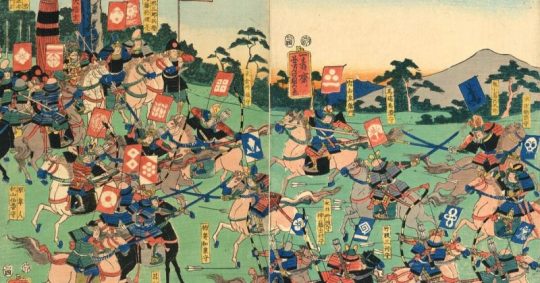
The Kabuki-mono have been recorded as a trend during the mid-late 1500s (the tail end of the period of Japan’s first major unification under Nobunaga Oda and his direct successor, Hideyoshi Toyotomi; of note is that the unification had ended the preceding Sengoku Jidai/Warring States era) into the turn of the 1600s.(Around which time the rise of the Tokugawa shogunate brought with it strict social rules that quashed a number of different social customs and trends, the Kabuki-mono among them.)
What this means is that for nearly 200 years Japan had been in a state of constant war; this same time period is where the romantic images of the cultural myths of the samurai were cultivated. For nearly 200 years Japanese society had built itself around the inevitability of war: profit and loss came from raiding and conquering of territory, the warrior caste earned its social value according to its very real measures of worth in battle, and the dynamic of courtly politics was sustained by the privileged ruling class propped up on their military power and holdings. For 200 years and all the generations that were born raised and died in it amassing soldiers, training for war, and winning social status and wealth in battle were a way of life. And then peace came.
(So jarring in fact was the shift towards peace that the need to justify a bloated military force even pushed Japan to try and invade the Asian mainland, just to give their restless and disenfranchised soldiers something to do.)
But the awkward shift in life styles meant that while the highest echelons of Japanese society adapted to more peaceful politics, the middling ranks of aristocracy found themselves without wars to fight, without real political influence, and without roles in society: Many families found their heirs provided for, spoiled even, but aimless. Herein came the ronin and wandering samurai that would become the beloved trope of samurai fiction for centuries to follow.
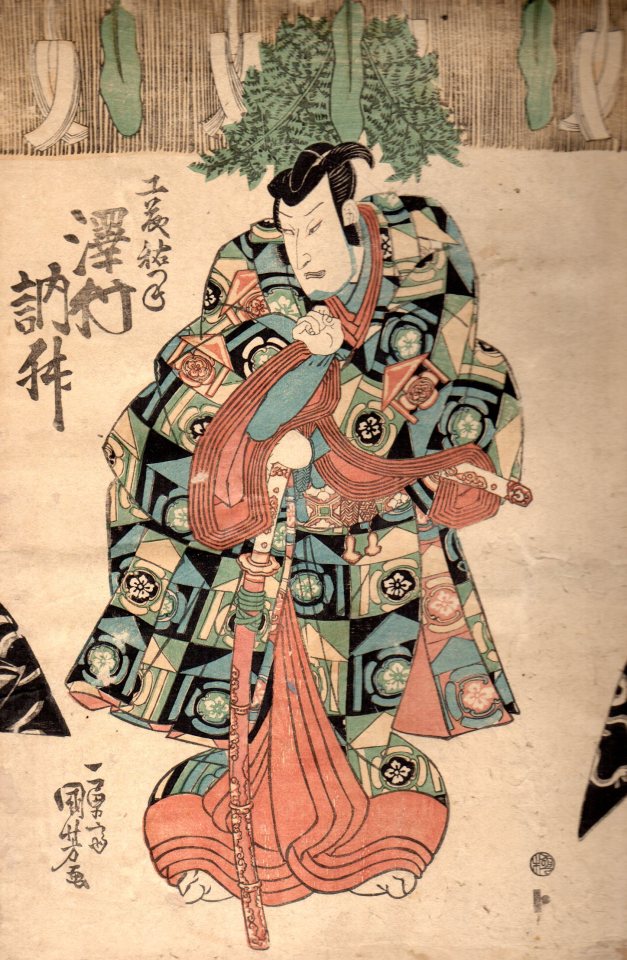

But among these disenfranchised yet financially well off (and very frequently well educated and cultured) soldiers were some who took to posturing their status, very probably as a direct result of their losing real power in courtly affairs as practices skewed toward the nuance of peacetime politics. So, as if to announce their wealth and culture they would being to dress lavishly to show off their money, both to one another and to the peasantry. Their tastes leaned into the gaudy, favoring bright colors, elaborate patterns, and exotic fabrics like leathers, animal furs, and light catching materials. They also adorned themselves in beaded charms, metals, and even decorated their swords and sword sheathes. Also popular became the almost comically large swords, again commissioned as a matter of social posturing; often depictions of Kabuki-mono will show them leaning on their swords while standing upright, using them as walking sticks, or slung over their shoulder to bare the heavy load.
From this M.O. there came a fairly logical development in style; many of these fashionable ex-samurai began to collect women’s clothing, because of the available clothes women’s possessed all the traits they found desirable. For some this amounted to cross dressing, but because women’s clothes were often too small for the men to wear properly, they would drape them as capes, or fashion them into sashes. This in turn lead to layering many articles of clothing over one another, as it allowed for a maximum of patterns and fabrics to be incorporated into a single ensemble. But for those who were able to wear women’s clothes comfortably, or who had women’s styles fashioned in their own sizes, the fuller feminine aesthetic carried over with, and accessories also came into vogue for the Kabuki-mono. Moreover, many would also wear their hair down (but not cut, as the length was still indicative of status, but the topknot itself being explicitly masculine) rather than in the traditional topknot, which had the effect of also evoking a more feminine style.
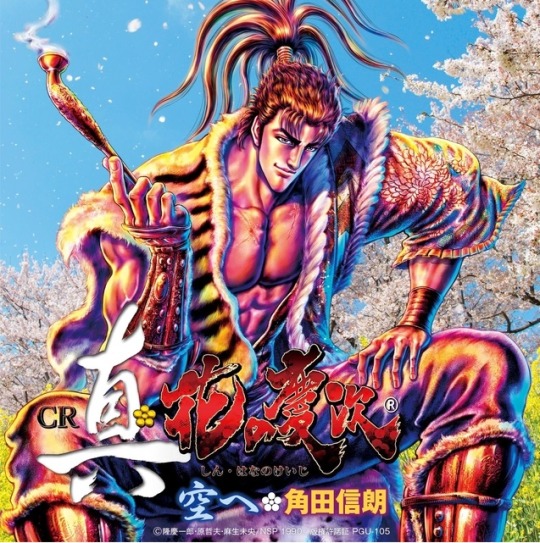
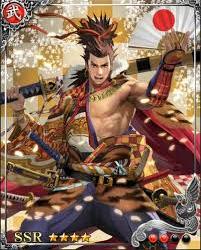
In practice these boastful and again financially frivolous groups of eccentric fashionistas would spend their time wandering lively urban areas to show off their visible wealth, or spending their time smoking* and drinking together in taverns where they were frequently known to skip bills. (it’s entirely likely many of them didn’t even have real money left to their name after the benefits of the war economy subsided)
Keeping in mind that this was an era in which their samurai status, however impractical in courtly politics, did still technically afford them a kind of diplomatic immunity and power over peasantry. So when I say they “skip their bills” it wasn’t so much a tricky dine and dash as it was a bold and arrogant saunter out the door with the utmost confidence that if a pub owner were to try and stop them, they could beat the commoner even to death with relative impunity.
In this same vein they were known to get quite readily into drunken brawls and wrestle in the streets with other “gangs.” But of course “wrestling” here is actually the jujutsu that had commonly been part of a samurai’s military training.
And in this way common hang outs for different groups of displaced soldiers would become centers of what were basically gang turf, and these casually belligerent interactions and retaliations to them would begin to carry with them larger consequences.
A small aside that doesn’t quite fit anywhere else here: Another accessory to their aesthetic were large custom made Kiseru (a kind of Japanese smoking pipe with metal mouth piece and bowl) like their swords, crafted comically large as to make a loud statement. Some accounts of fights between gangs actually describe pipes so large and with such prominent metal components that they could be used as weapons to fend off an unexpected attack, even from a sword or dagger. (ironically this trope has developed in one of two ways over the years, either exaggerating the size of the pipe further, or downplaying its size to that of a regular pipe to create a kind of dissonance where a skilled fighter can wield even a small inconspicuous object as a weapon.)
As these kinds of gangs grew in size, activity, and influence they did eventually attract the attention and ire of their superiors. By the time the Tokugawa shogunate took over, they were on a short list of black listed groups targeted by legal reforms that outlawed, not the groups themselves, but much of their behavior and practices, affording the shongunate the impetus to act on arrests, that would do away with key leaders, until the gangs eventually dissipated on their own.
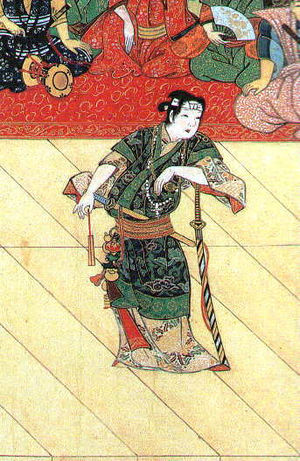
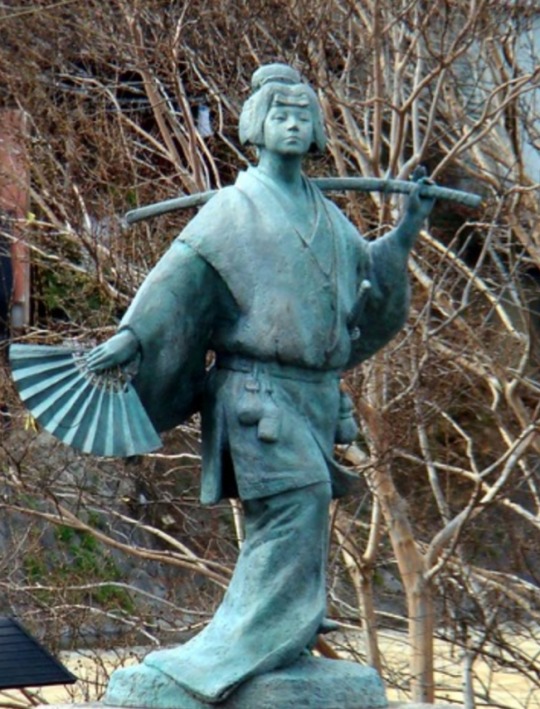

But there was another set of eyes that had been following the kabuki-mono activity, even in its waning years: one Izumo no Ikuni. The woman who would go on to found Kabuki theatre while the memory of the Kabuki-mono was still in the public mind even as they vanished from the bars and streets. It is from the kabuki-mono that Kabuki theatre would develop its audacious costume and distinctly pronounced mannerisms and even characterization of samurai. It is also the alluring androgyny of the Kabuki-mono’s fashionable men that led Izumo no Ikuni and her all female troupe to so readily and confidently assume the masculine roles. (Ikuni herself was known to address her audiences directly, with no formal traditions of a 4th wall, and flirt with women while in character to great if often notorious effect.)
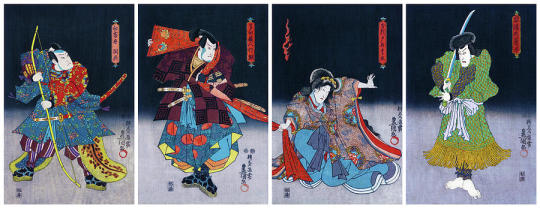

A curious side effect of this passing of the torch is that the strong associations with theatre fashion actually caused a lot of other media to distance themselves from various associations with theatre by effectively relegating the kabuki-mono fashion to the domain of theatre almost exclusively. So stories about poor and disenfranchised samurai in the years following the Warring States period adopted a kind of universal trope of the plain clothes samurai, in rough and worn kimonos, or else distinguished formal wear befitting the status of the higher rungs, but nearly eradicating the image of the Kabuki-mono from any fiction that didn’t specifically feature them.
I guess my point is just that it's super cool to me that there was this whole brief era where a bunch of war hardened, genderbending, fashionista thugs were just kicking around Kyoto picking fights and showing off. And its a damn shame that circumstances as they are have kind of erased them. Also they so very much embody and legit pioneered the spirit of Bad Suit Energy that sustains me.
14 notes
·
View notes
Text


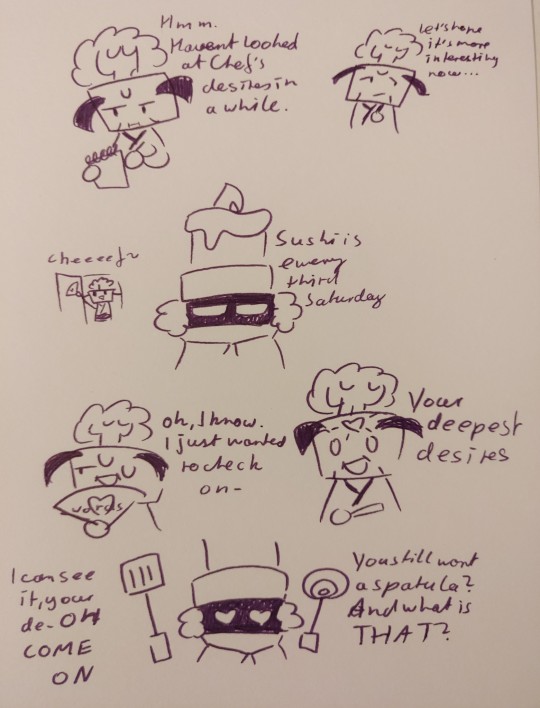


According to google translated Lost Qualia, Mono Eye Wizard is Frog Fortune Teller's husband? Good for them. Good for them.
#arts#gregory horror show#ghs#ghs hell's chef#ghs hells chef#ghs mono eye wizard#ghs frog fortune teller#ghs bonsai kabuki#hell's chef#hells chef#mono eye wizard#frog fortune teller#bonsai kabuki
37 notes
·
View notes
Text
Promo Post !!

Hello! This is a Gregory Horror Show x Reader blog since there hasn’t been any x reader content for GHS on Tumblr that I’ve seen. This blog will focus around readers who have already turned into permanent residents. If specified, it can also be a human protag ! I will do:
SFW
Headcanons
Short drabbles
I will NOT do:
NSFW
Angst (Unless I’m in the mood don’t expect it)
this one is IMPORTANT.
I WILL NOT DO x READERS WITH ANY OF THE CHARACTERS BELOW 18. THE ONLY EXCEPTION TO THIS IS IF THE RELATIONSHIP IS PLATONIC OR FAMILIAL. THIS NEEDS TO BE SPECIFIED IN REQUEST.
With that said, requests are open!
#ghs x reader#gregory house#Gregory horror show#ghs#gregory#mono eye wizard#catherine#clock master#dr fritz#cactus gunman#cactus girl#bonzai kabuki#judgement boy
50 notes
·
View notes
Text






Welcome to episode 2647568272919 of When The Hell Did I draw This? featuring Gregory Horror Show
#ghs#gregory horror show#shitpost#bonsai kabuki#mono eye wizard#dr fritz#ghs death#gregory horror show death#gregory#ghs catherine#stephen haniwa#stephen haniwa salaryman#cactus gunman#swearing tw
106 notes
·
View notes
Text


Full collection of figures for Gregory horror show collectible game experience. I have tonnes of double ups for nearly every character that I'm willing to part with for any other fans of this obscure game.
#ghs#ghs gregory#gregory horror show#neko zombie#mono eye wizard#Catherine#mummy papa#mummy dog#egypetit#unbaba#bonsai kabuki#dr.fritz#musha dokuro#cactus gunman#cactus girl#ghs figures
24 notes
·
View notes
Photo









Tamashii Nations | Marvel Manga Realization | Kabuki Mono (Deadpool)
58 notes
·
View notes
Note
Little nightmore au
Mono and six au swap
Imajen pls

(I tried lol xDD I gave Thin Man a kabuki mask ^w^)
#spoilers#ln spoilers#little nightmares spoilers#little nightmares 2 spoilers#Lady just looks very proper while Thin Man continues to be terrifying xDD#my art#little nightmares#little nightmares 2#fanart#six#mono#little nightmares six#little nightmares mono
2K notes
·
View notes
Text
Kabuki mono - MITSUMOTO Yoshiharu

A oneshot from AX v.83.
Download


1 note
·
View note
Text
Animation Night 51 - Kizumonogatari
Look, we’ve gone several weeks without anything deeply weebish, I have a reputation to maintain here!
Hey friends, I have somehow avoided getting kicked off this website. I have backed up the Animation Night posts locally, though it’s going to take a bit of work to publish the archive on my giþub site!
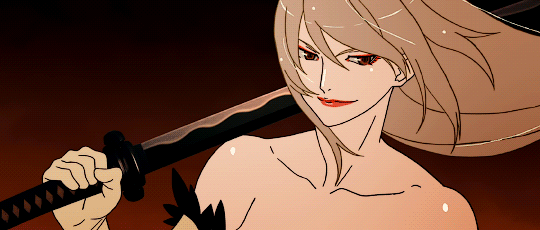
So, what’s this week about? Studio SHAFT were in their heyday known for two things: the rightly legendary Puella Magi Madoka Magica, which we watched back on Animation Night 10, and is apparently soon to receive a new film... but mostly, the much longer Monogatari series. Starting with Bakemonogatari (2009), this stood out a great deal (and did a lot to establish the SHAFT style): a distinctive blend formal experimentation, dense literary allusions, tight blink-and-you’ll miss it editing with creative use of text, and a wry, discomforting sense of humour.
Monogatari entered the world as a series of light novels by the startlingly prolific Nisio Isin (or NisiOisiN as he prefers it!), centred on a boy named Koyomi Araragi who falls into the orbit of a long succession of supernaturally-afflicted girls. Though that premise probably makes it sound sorta harem-adjacent, and Araragi does get together with one of said girls by the end of Bake-, what I’ve seen of it primarily treats this premise more as a framing device for quite varied supernatural stories; some more horror-oriented, some more comedic. Each entry in the series is titled a pun in the template of [something]monogatari, after a traditional literary form that connotes similarly to ‘tale’. Typically these pormanteau with the kanji 物 (mono, roughly just ‘thing’), so...
化物語 Bakemonogatari (after 化物 bakemono meaning monster)
偽物語 Nisemonogatari (after 偽物 nisemono meaning counterfit)
猫物語 Nekomonogatari (not really a pun, just 猫 neko meaning cat lol)
傾物語 Kabukimonogatari (傾 meaning slope, with afaict a very unusual reading presumably to bring to mind kabuki theatre? or the flamboyant kabukimono samurai gangs? i don’t get this one)
and so on...

I can’t say too much about the light novel series, or how it compares with others of the genre, beyond that it’s reputed to be very wordy! I do know the task of adapting this fell into the hands of directors Akiyuki Shinbo and Tatsuya Oishi at SHAFT, and they evidently wanted to make something rather avant-garde!
Some of their ideas included things like attempting to capture the interiority of a character by blacking out the screen as if for blinking with ‘black’ or ‘red’ scenes:
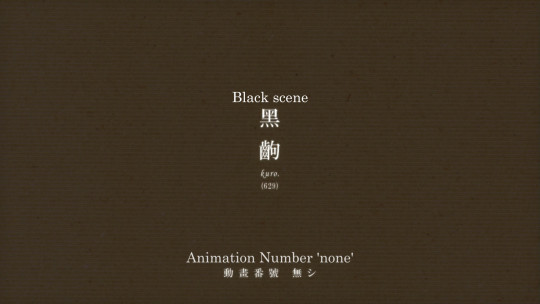
...which along with the editing gives the whole production a distinctive rhythm. Other tricks involve extensive use of typography (e.g. flashing up a definition for a few frames), editing to kabuki sounds (each episode beginning with the an accelerating series of beats with passages from the original novel alongside them), and heavy use of geometric patterns and digital effects in the photography: gradients, stark silhouettes, a very stylised modern world yet strangely sterile and empty of people beyond the MCs. They would moreover do unusual things like using real photographs in backgrounds to create constant variation.
And while the drawing count wasn’t unusually large or anything like that - quite the opposite, often there would be almost entirely static, lingering scenes - even those static talking heads scenes would be shot with an unusual pose or composition to make it interesting. Then at key moments, they would drop some really innovative, heavily impactful key animation, such as this legendary fight scene [continued, cw gore, incredible sequence ^^] by Hironori Tanaka, Genki Matsumoto, Gen’ichiro Abe and Ryo Imamura, which made full use of the protagonist’s healing factor.

This approach proved a hit, and they were set to make many, many more adaptations of Monogatari. For a detailed retrospective on the series and its influences, kVin has you covered. (Literally I would be totally at sea without this guy lol.)
Starting in 2011, Oishi went to work on the film series, 傷物語 Kizumonogatari (which we could translate as 'Would Tale’), which was released from 2016-17, telling the first part of the story as a prequel to Bakemonogatari. Although the production was delayed years thanks to Oishi’s ambition, leaving the main series in the hands of an at first much less experienced Tomoyuki Itamura, the final result seems to have paid off, at least going by kVin’s enthusiasm...
The biggest fan of NisiOisiN’s prose is NisiOisiN himself, and so the Monogatari series is renowned for being verbose by both fans and critics. Kizumonogatari is written as the chaotic stream of consciousness of Koyomi Araragi, but Oishi decided to do away with narration and monologues entirely; he took a book that exists inside the mind of a character and tried to make all his feelings explicit and yet portrayed in an unobtrusive way. Not dropping any relevant details without outright stating anything was by all means a crazy idea. And what’s even more outrageous is that he succeeded with his elegant but thoroughly insane solution – eventually at least, I wouldn’t be surprised if he had to redraw his storyboards countless times to achieve it. The Show, Don’t Tell principle has become a bit of a poisonous idea on the internet thanks to reductive fans interpreting it as a rule rather than a powerful approach, but this film pulls it off to an extreme that shouldn’t even be possible.
For a very detailed blow by blow of the various creative things being done, you can read more here.

Unlike the more static TV series, these films are carried throughout by some frankly incredible kagenashi (unshaded) character animation, full of intense expression and inventive touches. These lively animation designs consciously contrast with the (apparently somewhat controversial) decision to set everything in realistic CGI backdrops - which do not attempt to look cel shaded or painted at all, but it seems to fit a production like this much better than the overly-shiny cars in Psycho-Pass, and fits the studio’s habit of being ahead of the curve in adopting digital tech.
So what’s all this in service of telling? In Kizu-, Araragi gets his first encounter with a supernatural girl in the form of (deep breath) the vampire Kiss-shot Acerola-orion Heart-under-blade. Moved to offer his blood up to save her from vampire hunters, he finds himself made a vampire thrall tasked with retrieving her lost limbs.
As far as content: some gore is p much a given in this scenario, but heads up that Monogatari is also known for its improbable fanservice shots. In terms of artistic intent, this is perhaps another element in drawing us into the subjectivity of a teenage boy. And in terms of what to expect, it definitely sounds like these are sometimes used, as in here, in a way designed to discomfort rather than gratify the audience.

My impetus for picking this one out is a fascinating series of staff interviews that were translated on Sakuga Blog over the past month. Something that got this much attention, and kVin’s obvious immense enthusiasm - not to mention the clips picked out! - definitely got my interest. I’m looking forward to seeing it all together.
With the density of allusions and complex typography, this series is quite a challenge to subtitle - but luckily various groups have risen to the challenge over the years. In this case we have a kind of improbably sophisticated sub by Commie, who went to the trouble of not just matching all the fonts and such but even animating the colour changes to match the typography in the series...
Luckily for Animation Night scheduling, most of these movies are pretty short - just over an hour typically - so we should easily be able to get through all of them in one night. Animation Night 51 will begin at 7pm UK time, 3 hours from this post, at the usual spot - twitch.tv/canmom!
22 notes
·
View notes
Text
Japan playlist

Are you turning Japanesa? I don’t think so! This, I believe is the ultimate Japan playlist. One of my favorite countries in the world to visit. it truly is a fascinating place in the world. The music from this region is just so. Crazy even! I have been a few times and cannot wait to get back over there again as soon as Crap-19 takes a hike and leaves this planet already. Meanwhile, here is the Japan playlist to keep us happy. Perfect for those of you out there in lock down.

I hope you dig the list of songs I put together. You can even let me know what songs or bands I forgot and let me know! 私はあなたがそれを掘ることを望みます Arrigato! Hit play right here: https://www.youtube.com/playlist?list=PL-iHPcxymC1_IcliLasW5eajllU8pA5Gh
JAPAN
001 Fantomas - 4-30-05 002 INXS - I Send A Message 003 LADYBABY - candy 004 Babymetal - DoKiDoKi MORNING 005 MOMOIRO CLOVER Z vs KISS - YUMENO UKIYONI SAITEMINA 006 The Cure - Kyoto Song 007 Kill Bill Vol.1 - Isaac Hayes - Run Fay Run 008 CHAI - GREAT JOB 009 Mutant Monster - Barabara 010 Sigh - Inked in Blood 011 The Vapors - Turning Japanese 012 Fantomas - 4-7-05 013 Ocean Machine - Night 014 Masayuki Sakamoto - Psy'chy 015 Astro Boy - 1980 English Intro Theme 016 Go Misawa - 悪魔人間 (デビルマン) - 不動明 017 Red House Painters - Japanese To English 018 八十八ヶ所巡礼「仏滅トリシュナー 019 Acid Mothers Temple - Floating Flower Shizuku No Youni 020 Ween - Japanese Cowboy 021 Otoboke Beaver - Don't light my fire 022 Gojira's Godzilla Theme Song 023 Cavalera Conspiracy - Bonzai Kamikazee 024 Ultra Bide - DNA vs DNA 025 David Bowie - Crystal Japan 026 A Flock Of Seagulls - Tokyo 027 Sakura - Cherry blossoms 028 BON JOVI - Tokyo Road 029 Aneka - Japanese boy 030 Endon - Boy Meets Girl 031 Junko Ohashi - Dancin' 032 Ike Reiko - Yoake No Scat 033 Shohjo-Tai - Flamingo Island 034 Chthonic - Kaoru 035 Herbie Hancock - Nobu 036 Akiko Yano - Dogs Awaiting 037 Inoyama Land - Glass Chaim 038 Fantomas - 4-14-05 039 Hide - Dice 040 Japan - Talking drum 041 Sabbat - Samurai Zombies 042 Brian Ice - Tokyo 043 W.A.S.P. - Tokyos on fire 044 UHNELLYS - SWITCH 045 Boris - LOVE 046 Kill Bill Vol. 1 - Battle Without Honor or Humanity Tomoyasu Hotei 047 eX-Girl - Pretty You Ugly 048 Gonin Ish - Shagan No Tou 049 Banana Erectors - Fed Up With Highschool Days 050 Strapping Young Lad - Japan 051 Yoshida Brothers - Ibuki 052 Zeni Geva - Total Castration 053 Flower Travellin' Band - Satori, Pt. 1 054 MOMOIRO CLOVER Z - GOUNN - 055 Tom Waits - Big In Japan 056 ABIGAIL - A Witch Named Aspilcuetta 057 Sigh - The Tombfiller 058 Marty Friedman-Dragon's Kiss-Dragon Mistress 059 RIOT - Tokyo Rose 060 Fantomas - 4-13-05 061 Guitar Wolf - High Schooler Action 062 Becoming a Geisha - Memoirs of a Geisha Soundtrack 063 Seven Samurai- Ending Theme 064 Miki Sugimoto - Rei's Ballad (Theme from Zero Woman Red Handcuffs) 065 Yoshida Brothers - Rising from Best Of Yoshida Brothers 066 Ruler - Jeanie Jeanie Jeanie 067 Kill Bill Vol. 1 OST - Twisted Nerve - Bernard Herrmann 068 Fantomas - 4-23-05 069 Shonen Knife - It's a New Find 070 Polish National Radio Symphony OrchestraKrzysztof Penderecki - Threnody to the Victims of Hiroshima 071 ACID MOTHERS TEMPLE - Helen Buddha; Miss Condom X 072 Shugo Tokumaru - Decorate 073 PiGu - Bye Bye Honey 074 Hello Kitty Theme Song - Hello Kitty 075 ACUTE - 生き地獄 076 Sabbat - Karmagmassacre 077 Yellow Magic Orchestra - Tong Poo 078 Yojimbo OST - Main Theme 079 Anpan-man (Red beans bread man)theme song 080 Ex-Girl - The Crown of Dr. Keroninstein 081 Kate Bush - [The Whole Story] Breathing 082 Coffins - Hatred Storm 083 The Books - Tokyo 084 Fantomas - 4-19-05 085 男の一生/松方弘樹 086 Azuma Kabuki Musicians - Dojoji 087 Saxon - Walking Through Tokyo 088 Kill Bill, Vol. 1 Original Soundtrack - The Flower of Carnage - Meiko Kaji 089 Les Rallizes Denudes - Now is forever 090 G.I.S.M. - Nih Nightmare 091 Mono - Silent Flight, Sleeping Dawn 092 Deftones - Romantic Dreams 093 Strapping Young Lad - Zen 094 Dead Can Dance - Kiko 095 Kinoco Hotel - キノコホテル「キノコノトリコ」 096 Esashi Oiwake - Ensemble Nipponia 097 Naitemo idayoi - bcmomoiro clover 098 Bryan Ferry - Tokyo Joe 099 Suzuki Junzo - Crying Out Double Suicide Blues 100 Iron Maiden - Sun and Steel 101 Kikagaku Moyo - Dripping Sun 102 Fantomas - 4-3-05 103 BARBATOS - Tokyo Rock'N Roll Show 104 BABYMETAL - MEGITSUNE 105 Eternal Elysium - Shadowed Flower 106 The Erections - stupid punk 107 The Seatbelts - Cowboy Bebop (Original Soundtrack 1) 108 Rush - Manhattan Project 109 Today Is the Day - Samurai 110 Fullmetal Alchemist Brotherhood OST - main theme 111 Japanese War Music - Samurai Battle March 112 Steel Panther - Asian Hooker 113 The Mount Fuji Doomjazz Corporation - A Place For Fantasies 114 Guitar Wolf - FIGHTING ROCK 115 HEAVY METAL ARMY - That's Hammurabia 116 Michale Graves - Godzilla 117 Noriko Miyamoto - My Life 118 Loudness - Ashes in the Sky 119 Mary's Blood- Save the queen 120 Mellvins - One Fine Day 121 High On Fire - Bastard Samurai 122 Shakuhachi - The Japanese Flute 123 Luna Sea - IN SILENCE 124 Tatsuro Yamashita - Sparkle 125 PIG DESTROYER - Kamikaze Heart 126 Tomoko Kawada - Akanegumo 127 Sodom - Kamikaze Terrorizer 128 Carlos Toshiki and Omega Tribe - Sky Surfer 129 TOKKAEBI - cheon mun 130 Pere Ubu - 30 Seconds Over Tokyo 131 Wanda Jackson - Fujiyama Mama 132 Witch Cross - Night Flight To Tokyo 133 F.O.E. - Total Eclipse 134 Coffins - The Frozen Styx 135 Sword of Doom (1966) - Main Theme OST 136 Sigh - The Transfiguration Fear 137 Yondemasu Yo, Azazel san - Opening song 138 Thundercat - Tokyo 139 GHOST IN THE SHELL O.S.T.2 - i can't be cool 140 Japandroids - No Allegiance to the Queen 141 YAMANTAKA - SONIC TITAN - Hoshi Neko 142 Doraemon 2005 Opening - Sha La La 143 Akira Soundtrack - Kaneda's Theme 144 Anatomia - Morbid Hallucination 145 Traditional Japanese music - Honno-ji 146 Kodo - Lion 147 Tomita Planets - Mercury, The Winged Messenger 148 Yuji Ohno - Lupin The Third Theme '78 149 Ninja Scroll TV Series Soundtrack - Jubei's Theme 150 OKAWARI_BOY show me your space 151 Boris - The Woman on the Screen 152 Sepultura - Kamaitachi 153 X Japan - X 154 L'Acephale - Hitori Bon Odori 155 Zilch (hide) - Inside the Pervert Mound 156 Fantomas - 4-12-05 157 Kodo - Akatsuki 158 Sigh - Hunters not horned 159 Pucca Theme song 160 Tujiko Noriko - Solo - Magic 161 MYSTERY KINDAICHI BAND - THEME OF KOSUKE KINDAICHI 162 Akiko Yano - クマ 163 Sooo Baad Revue - バッド・レビュ 164 Pharoahe Monch - Simon Says (instrumental) 165 Imaginary Flying Machines - Sanpo (My Neighbor Totoro) (feat. Living Corpse & Yoko Hallelujah) 166 Mutant Monster - kamisama o negai - pv with romaji lyrics 167 Mount Fuji - Neun 168 Kumi Sasaki - Tanchame Bushi 169 Yakuza - Yama 170 Chai - Choose go! 171 Goto Mariko – Drone 172 Blue Oyster Cult - Godzilla 173 Kinoco hotel – F No Junkai 174 ASS BABOONS OF VENUS - Jet Unchi 175 James Bond you only live twice OST - Aki, Tiger and Osato 176 PJ Harvey - Kamikaze 177 BABYMETAL - Awadama Fever 178 Alcatrazz - Hiroshima Mon Amour 179 Tokyo Blade - Warrior of the Rising Sun 180 TIK & TOK - TOKYO GIRLS 181 Queen - Hammer To Fall 182 Nana Kitade - Kibou No Kakera 183 Gallhammer - Blind my eyes 184 Yellow Magic Orchestra - Kai-Koh 185 Chikyuu Kyoumei Resonance of the Earth 186 Hoodoo Gurus - Tojo 187 John Waite - Euroshima 188 Tommy Snyder / Yuji Ohno) - ザ・マリン・エクスプレス (The Marine Express) 189 Boris - Riot Sugar 190 Yellow Machinegun - Again 191 Kill Bill, Vol. 1 Original Soundtrack - The Lonely Shepherd 192 Church of Misery - Chilly Grave 193 Jimmy Takeuchi - Yasuki bushi (Shimane) 194 Yuji Ohno "Andromeda no kanata ni" - (OST - Captain Future) 195 Bo Ningen - Henkan 196 Blood Stain Child - Electricity 197 Crime - Yakuza 198 Tatsuya Yoshida & Satoko Fujii - Feirsttix 199 Ike Reiko - Kokotsu No Sekai 200 Fantomas - 4-9-05 201 David Bowie - It's no game 202 Manon - xxFANCYPOOLxx 203 Sparks - Here In Heaven 204 MAD SPYAIR - samurai heart Gintama 205 Terror Squad - Nightmare Rider 206 Fantomas - 4-6-05 207 Mutant Monster - Hanabi 208 Jimmy Takeuchi - Akita obako 209 NAKED CITY - OSAKA BONDAGE 210 Death Panda theme 211 Crossfaith - Monolith 212 OMD - Enola Gay 213 Dir en Grey - Obscure 214 LADYBABY Age-Age Money 215 Fantomas - 4-17-05 216 S.O.B. - Deceiver (Napalm Death cover) 217 Jimmy Takeuchi - Time Of The Season 218 Dark Mirror Ov Tragedy - Thy Sarcophagus & Unwritten Symphony 219 Laurie Anderson - Kokoku 220 THOMPSON TWINS - TOKIO 221 Electric Eel Shock - Killer killer 222 Kodo - Nanafushi 223 Ningen Isu - Heartless Scat 224 Amachi Shigeru – Showa Blues 225 BlackLab - Insanity 226 TENGGER - achime 227 Riot - Narita 228 Martin Denny - Japanese Farewell Song (Sayonara) 229 LADYBABY - Renge Chance 230 Tokyo Electron - She Keeps Me Shut 231 Kan Mikami - Anata Mo Star Ni Nareru 232 Kraftwerk - Radioactivity 233 CHAI - N.E.O. 234 Fantomas - 4-27-05 235 Gacharic Spin - Next Stage 236 Loudness - Crazy Nights 237 David Bowie - Merry Christmas Mr. Lawrence 238 The Presidents of the USA - Japan 239 Fantomas - 4-4-05 240 Kyary Pamyu P - Fashion Monster 241 Wagakki Band - Senbonzakura 242 Deep Purple - Woman From Tokyo 243 Krokus - Tokyo Nights 244 Kyoto - Venetian Blinds 245 Happy End - Natsu nandesu 246 Motohiko Hamase - Plateau 247 Boris - Tokyo Wonder Land 248 Asia - Countdown to Zero 249 Hiiragi Fukuda - Me And My Marshall Amp 250 Marty Friedman - Ai Takkatta 251 Kodo - O-Daiko (japanese drummers - Taiko - tambours geants Japon) 252 Sonic Youth - Tokyo Eye 253 Otoboke Beaver - Anata Watashi Daita Ato Yome No Meshi 254 Y&T - Midnight in Tokyo 255 Metalucifer - Heavy Metal Samurai 256 Urami Bushi - Meiko Kaji 257 Alphaville - Big in Japan 258 M.O.D. - Godzula 259 Akiko Yano - Hitotsudake 260 Japan - Life in Tokyo (Giorgio Moroder Version) 261 Boris with Merzbow - Sometimes 262 Dragonforce - Power Of The Ninja Sword 263 Fantomas - 4-10-05 264 The Guyver Dark hero Theme song 265 Minami Deutsch / 南ドイツ - Futsu Ni Ikirenai 266 Yukihiro Takahashi - Drip Dry Eyes 267 ZooBOMBS - Doo Bee 268 SIGH - Shingontachikawa 269 Burt Bacharach - Me Japanese Boy I Love You 270 Kay Cee Jones - Japanese Farewell Song 271 Dhidalah - GRB 272 Kikagaku Moyo - tree smoke 273 The Fall - I Am Damo Suzuki 274 Ryuichi Sakamoto - Thousand Knives 275 Yasuaki Shimizu - kakshi 333 Godiego - The Birth of the Odyssey (Monkey Magic) 666 BABYMETAL -Headbanger
Here are the songs to listen to: https://www.youtube.com/playlist?list=PL-iHPcxymC1_IcliLasW5eajllU8pA5Gh
#japan#Japanese Rock#japan playlist#japanese metal#Sigh#mike patton#ryuichi sakamoto#music from Japan#loudness#otoboke beaver#chai#metalucifer#Japanese movie soundtracks#ninja#babymetal#lady baby
38 notes
·
View notes